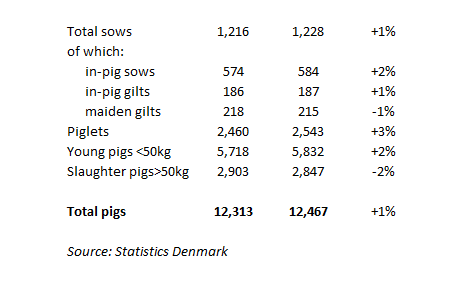



Danish Pig Breeding Herd Still Edging Up
DENMARK - The number of sows in Denmark has increased again based on data from the 1 July pig survey. This follows the small year on year increase in the 1 April pig count, according to Leo Colby, AHDB Consultant.However, the rise remains small, at only 1 per cent, in spite of further improvements in profitability as the finished pig market continued to move up.
The increase in the sow herd contributed to the 1 per cent increase in total pig numbers in July even though live exports have continued to move up.
The upturn in the breeding herd is confirmed by the fall in sow disposals, namely slaughterings and live exports, which were down by 4 per cent in January-May 2017.
However, in both April and July the increase in in-pig gilt numbers was still only around 1% on a year earlier while in July maiden gilt numbers declined by 1 per cent.
This would suggest that any further expansion in breeding pig numbers will remain muted.
Given the increased sow herd on 1 July and ongoing improvements in sow productivity, piglet numbers in July were again up on last year, by 3 per cent, and young pigs less than 50 kg, were 2 per cent higher.

In contrast the number of slaughter pigs over 50kg on 1 July was down by 2 per cent although this represents a substantial improvement over the 8 per cent reduction in April.
Live exports of weaners have continued to increase although at a smaller rate.
Data published by Landbrug & Fødevarer, the Danish agriculture and food board, indicates a 4 per cent increase in the first five months of 2017, compared to an 11 per cent rise in 2016.
This increasing trade is continuing to reduce slaughterings of clean pigs in Denmark which were down 8 per cent in the first five months of 2017.
This in turn is reducing domestic Danish pig meat production and hence export availability with total pig meat trade, excluding offals, down by 8 per cent in January to April 2017.
This in turn seems to be having implications in its trade with the United Kingdom, the second largest market for Denmark, which was down 4 per cent in spite of an increase for pork.







